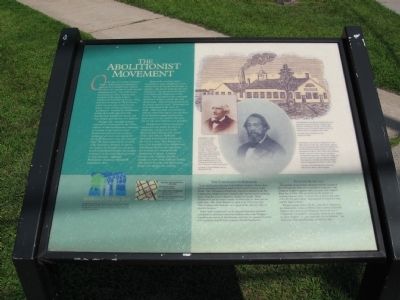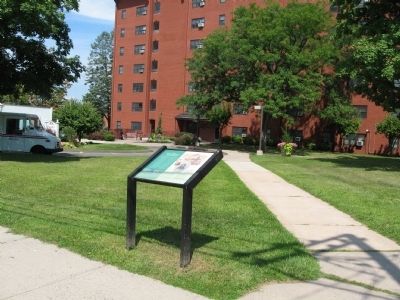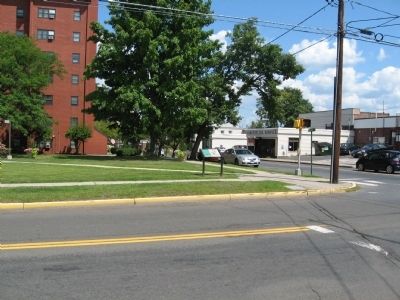Middletown in Middlesex County, Connecticut — The American Northeast (New England)
The Abolitionist Movement
On this site, on a spring evening in 1834, a violent mob descended on a small group of Middletown residents who had come together to work towards abolishing slavery. The abolitionists, both black and white citizens, were members of the newly formed Middletown Anti-Slavery Society. They held their meetings in a small factory, and it was here that a mob of local bigots – some of them prosperous “gentlemen” – attacked the abolitionists, pelting them with eggs and rocks, chasing them through the streets, and even cutting open the face of a minister.
Though only a handful of slaves remained in Connecticut by the 1830s, millions of African Americans continued in bondage in the southern states. Abolitionists believed slavery was a monstrous evil and a national sin for which all Americans must take responsibility. “We have supported the doctrine of the immediate abolition of slavery, not because we thought our own peace would be promoted thereby, but because we deem it to be a duty which we owed, to God and man,” explained Middletown abolitionist Samuel W. Griswold in 1837.
Many in the northern states including the Middletown mob declared that the North had no right to interfere with slavery in the South, and maintained that agitation over slavery could lead to the destruction of the Union. The pro-slavery men constantly threatened violence towards the local abolitionists. Samuel Griswold spoke for his group when he wrote, “It becomes us to be undaunted in the cause of truth …. Here we plant our feet and we will not retract one step to save our lives. If our blood is wanted, and the issue must come, we are ready for the issue, but we will never abandon our principle.”
Middletown’s African-American community was deeply involved in abolitionist activities, led by the Reverend Jehiel Beman, first pastor of the city’s African Methodist Episcopal Zion Church and himself the son of a slave. Rev. Beman was one of the founders of the Middletown Anti-Slavery Society; his sons Amos and Leverett also worked for the elimination of slavery. Leverett Beman’s wife, Clarissa, was the founder in 1834 of the Colored Female Anti-Slavery Society, only the second group of its kind in the country.
Jesse Baldwin, above, one of the founders of the Middletown Anti-Slavery Society, went so far as to carry with him his own supply of sugar, made by free laborers, so that he could avoid using slave-produced sugar when dining with friends. Baldwin’s house, a likely stopping place on the Underground Railroad, stood just behind you, across Broad Street.
The Middletown Anti-Slavery Society held its first meetings in the pump factory of William Benjamin Douglas on this site. Violent mobs broke up many of the gatherings, taunting the speakers and hurling eggs at their heads.
Courtesy of the Middlesex County Historical Society
Amos Beman, who came to Middletown in the 1820’s with his father, Rev. Jehiel Beman, became one of Connecticut’s most influential abolitionists. Prohibited from entering Wesleyan University because of his race in 1833, Amos had a Wesleyan student tutor him, until a group of students threatened to harm him. Amos later taught at a Hartford school for African-American children, then became a minister, and led the Temple Street Congregational Church in New Haven.
Courtesy of the Beinecke Rare Book and Manuscript Library, Yale University
The Underground Railroad Some abolitionists did more than publicly condemn slavery: they risked everything by helping fugitive slaves reach freedom in the North. The “Underground Railroad” was not a railroad at all, but a clandestine, illegal network of people that secretly moved escaping slaves along the route to freedom, usually in Canada. While Middletown had no secret tunnels, we know that the Railroad was active here. Rev. Jehiel Beman declared in an 1854 letter that “The Underground Railroad … is in good repair, and our office is open for business.”
Other local “conductors” on the Railroad may have included manufacturer and shipowner Jesse Baldwin; Benjamin Douglas, a manufacturer, mayor of Middletown, and later Lieutenant Governor of Connecticut; and William Lyman, a Middlefield farmer.
Fugitive Slave Act The growth of anti-slavery sentiment and the success of the Underground Railroad so infuriated southerners that Congress sought to appease them by passing the Fugitive Slave Act of 1850. The act increased the penalty for assisting runaway slaves to six months in prison and a fine of $1,000 for each offense and required all citizens to help capture fugitive slaves.
William Lyman, along with five fellow farmers in the Middlefield section of Middletown publicly decried the Fugitive Slave Law by publishing an open letter in the Middletown newspapers stating that “good citizens need not be slave-catchers any more than light seen shall be darkness and declaring, “this pretended law we will not obey.”
Middletown Heritage Trail the Middletown Heritage Trail is brought to you by the Middlesex County Historical Society, the Connecticut Humanities Council, the Middlesex County Community Foundation, Liberty Bank, and the City of Middletown.
Erected by the Middlesex County Historical Society.
Topics and series. This historical marker is listed in this topic list: Abolition & Underground RR. In addition, it is included in the African Methodist Episcopal Zion (AME Zion) Church series list.
Location. 41° 33.445′ N, 72° 39.008′ W. Marker is in Middletown, Connecticut, in Middlesex County. Marker is at the intersection of Broad Street and William Street, on the left when traveling south on Broad Street. Touch for map. Marker is in this post office area: Middletown CT 06457, United States of America. Touch for directions.
Other nearby markers. At least 8 other markers are within walking distance of this marker. Congregation Adath Israel (about 400 feet away, measured in a direct line); The General Mansfield House (about 600 feet away); Henry Clay Work (about 600 feet away); Middletown Soldiers Monument (about 700 feet away); Near This Site In 1750 (about 700 feet away); Middletown Honor Roll (about 700 feet away); Danforth Pewter Shop (about 700 feet away); Middletown (about 700 feet away). Touch for a list and map of all markers in Middletown.
Credits. This page was last revised on November 14, 2020. It was originally submitted on January 4, 2014, by Michael Herrick of Southbury, Connecticut. This page has been viewed 1,161 times since then and 30 times this year. Photos: 1, 2, 3. submitted on January 4, 2014, by Michael Herrick of Southbury, Connecticut.


